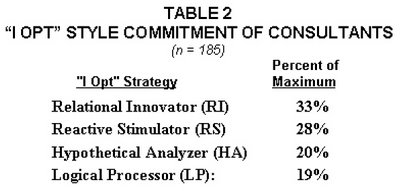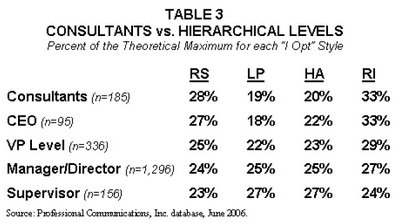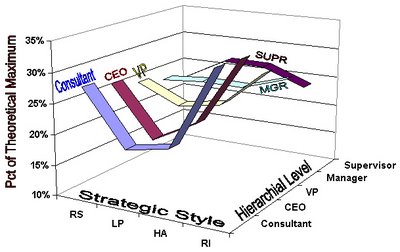 Professional Communications, Inc. (PCI), the creator of "I Opt" (see www.iopt.com for more information), maintains a large database of “I Opt” scores. This article uses this data to explore the characteristics of professional consultants.
Professional Communications, Inc. (PCI), the creator of "I Opt" (see www.iopt.com for more information), maintains a large database of “I Opt” scores. This article uses this data to explore the characteristics of professional consultants.BASIC CONSULTANT PROFILE
Consultants provide subject matter expertise. Clients contract with them to solve problems. Normally, the relationship is short-term. Once the issue has been addressed, the consultant moves on. The similarity in services offered, the nature of client relation and duration suggest that there will be a commonality in “I Opt” styles among consultants. This commonality is outlined in Table 2.

Not surprisingly, the idea-oriented Relational Innovator (RI) style is favored. Consultants are usually called when there is a vexing problem. The "usual" solutions have already been tried. The consultant is expected to bring in new ideas, options, and approaches. Consultants who consistently display this creative ability will be favored—and they are.
The strong secondary position of the RS might be somewhat unexpected. This "get it done" posture makes sense, however, when you consider how consultants are paid. They typically work on an hourly or daily basis (at the time of this writing, about $2,500 to $3,000 per day for a "typical" consultant). Clients pay for results. Analysis, evaluation, and assessment (an HA posture) do not usually qualify as the “results” being sought.
Comparing consultants to the general population highlights the uniqueness of the consultant's approach along both the idea and action dimensions.
FIGURE 1
FIGURE 2
REACTIVE STIMULATOR (RS)
REACTIVE STIMULATOR (RS)
 There are consultants in every strength category for both RS and RI. However, the degree of difference with the general population is striking. The general population dominates the distribution at lower strength levels. The consultants dominate at higher levels.
There are consultants in every strength category for both RS and RI. However, the degree of difference with the general population is striking. The general population dominates the distribution at lower strength levels. The consultants dominate at higher levels. Consultants are not always warmly received by the staffs of the client with whom they work. The difference in basic approaches to issues may be a basis for this result when it arises. From the perspective of the general employee pool, the consultant will not be approaching the issue in the "right" way. Compound this with the perceived high compensation (they do not see the unpaid hours) and a bit of tension is understandable.
A take home from the above observation is that a consultant should not expect affection from the people with whom they work in solving corporate issues. Some among the staff will see value in the approach. Most will not. Similarly, the client commissioning the work should expect to hear grumbles from the staff. The measure of success is the solution of the issue. One price of this solution may be a bit of disquiet among the lower levels.
INTERNAL vs. EXTERNAL CONSULTANTS
The "I Opt" database has a sample of 67 people who have been identified as internal consultants. Like external consultants, these people tend to be project oriented. They also move in and out of the various parts of the firm. The parallel between the work of internal and external consultants is strong. On its face, we would expect internal and external consults to approach issues in roughly the same manner.
Figure 3 shows the average strategic style strength of internal and external consultants. The similarity in style profiles is obvious, as are the differences.
FIGURE 3
EXTERNAL vs. INTERNAL CONSULTANTS
STRATEGIC STYLE COMMITMENT
EXTERNAL vs. INTERNAL CONSULTANTS
STRATEGIC STYLE COMMITMENT
 Overall, internal consultants have less of a commitment to the spontaneous RS and RI styles. These differences are academically significant (RS p<.05; RI p<.01 using the Mann Whitney U Test). Internal consultants also show a higher commitment to the disciplined HA and LP styles. The HA meets the academic standard of significance (HA p<.05) while the LP fails. Overall, it is fair to say that these differences are probably not due to pure chance.
Overall, internal consultants have less of a commitment to the spontaneous RS and RI styles. These differences are academically significant (RS p<.05; RI p<.01 using the Mann Whitney U Test). Internal consultants also show a higher commitment to the disciplined HA and LP styles. The HA meets the academic standard of significance (HA p<.05) while the LP fails. Overall, it is fair to say that these differences are probably not due to pure chance.Internal consultants will tend to be somewhat more disciplined. Their higher scores in HA suggest the greater use of disciplined thought. The higher LP suggests more stress on methodical execution. This posture limits the strength of the unpatterned RS and RI styles. The more discipline, the less spontaneity. The tradeoff cannot be avoided.
A moment's reflection suggests a possible reason. Internal consultants are paid a salary. "Real" consulting gigs are sporadic. External consultants leave. Internal consultants must find a way to stay busy inside the firm. Planning/analysis (HA) or executing established processes and programs (LP) are inviting activity candidates. These are low risk activities that keep you out of trouble as you await the next gig. As an internal asset, it is usually a good idea to save your ammunition for the times when you will need it.
The take home from this mini-analysis is that internal and external consultants are both similar and different. People can readily move between the categories. Client firms often hire their external consultants. Internal consultants often move into an external role. Both are viable strategies for the average consultant.
The mini-analysis also suggests the difficulties both types of consultants will face in a move to the other side. Internal consultants will tend to over invest (the HA and LP effects) in preparation. This will delay the point at which they will get traction. External consultants will tend to be a bit too aggressive. This posture will likely cause some political issues. These will delay their full integration into the firm. Both internal and external consultants will have crosses to bear if they move to the other side.
CONSULTANTS vs. HIERARCHICAL LEVELS
Consultants must sell themselves to get the gigs on which they depend. A first principle of sales is to “mirror” the prospect. The closer their “I Opt” style matches their prospect, the more likely it is that they will “connect” with them. That connection is the first step on the path to securing a new client.
The higher the hierarchical level of a prospect, the more likely it is that they will be able to sign the contract to solidify the gig. Table 3 shows the average “I Opt” style commitment of people at various hierarchical levels who might be able to “ink” a contract.

Table 3 shows that the average consultant most closely matches the profile of the average CEO. A correlation coefficient of .98 confirms the common sense notion that if a consultant can get the CEO, they should. The reception is likely to be warm. They are birds of a feather.
The problems a consultant is brought in to resolve, however, usually exist at lower levels. The normal state of affairs is that the consultant must traverse multiple levels before finding someone who will actually sign a contract. Figure 4 gives a picture of the "I Opt" style differences that exist at the various hierarchical levels.
FIGURE 4
CONSULTANTS vs. HIERARCHICAL LEVELS
Percent of the Theoretical Maximum for each “I Opt” Style
CONSULTANTS vs. HIERARCHICAL LEVELS
Percent of the Theoretical Maximum for each “I Opt” Style

The average values shown in Table 3 are plotted in Figure 4. The match between the average consultant and CEO is obvious. As you move down the hierarchy, the structure of the “I Opt” style pattern systematically changes. As you move down the hierarchical scale, the middle of the bands in Figure 4 flex upwards. This section of the chart represent the commitment to the disciplined HA and LP styles.
At lower levels, facts and logic dominate—prospects want to be shown that your proposal is likely to work. As you move up the scale, facts and logic become less important. The creativity of your ideas and a willingness to act quickly becomes more important. The risk is that the consultant will not recognize that the game is changing as a proposal migrates up the chain.
Entry level work usually involves appeasing lower level executives. Elaborate and detailed presentations are in order at these levels. These productions usually require a lot of work. The consultant will be tempted to amortize his/her investment by carrying it to the next level. The higher the jump, the less effective will be the “let’s reuse what we have” strategy.
The take home from this mini-analysis is the consultants must be willing to invest. Proposals must be retooled if more than one level is involved in getting a gig. The work done at lower levels becomes backup. It might be needed because not everyone at a particular level is average. However, as you migrate up the chain, increasing effort should be invested in principles, concepts and action options. Less should be invested in “why” and “how.”
SUMMARY
The Organizational Engineering database has enabled us to make some useful observations on consultants both internal and external. These include:
- Consultants are not like everyone else. An information-processing strategy leaning toward spontaneity in ideas and action is favored.
- The higher you go up in the hierarchy, the more likely it is that the consultant will “connect” with the prospect. The often repeated advice to “shoot for the top” is good counsel.
- If you have to navigate different levels to get the contract inked, expect to invest in retooling your proposal. Attempting to save work by reusing a presentation at different levels may be a formula for failure.
- If you get the gig, prepare the client for a bit of discord. On the whole, the internal staffs may not warmly receive your efforts. You are going to approach the issue differently than they might prefer. The reason you are there is to offer a different approach. A bit of tension is a natural outcome of this condition.
- Going over to the other side is a viable strategy. The external consult has an exposure in being a bit too aggressive. The RS and RI strategies that kept you alive when on the outside can be a source of political friction when you are on the inside.
- The internal consultant moving to the outside is likely to spend a bit of time getting traction. There might be a tendency to over-invest when preparing. This time would be better spent in marketing. There might also be a bit too much reliance on traditional, proven methods. People hire you because you bring a new perspective. Pulling out too many well-worn tools diminishes one of your principal competitive advantages.
The websites www.iopt.com and www.oeinstitute.org can orient you to the standard tools and their practical applications in the real world. This Blog demonstrates that the data collected in those applications can have a value in and of themselves. The “I Opt” information-processing approach is able to yield continuing, as well as, immediate benefits.
